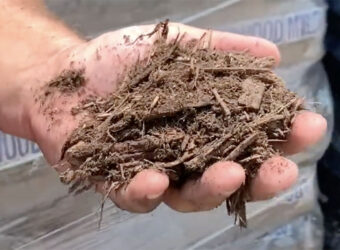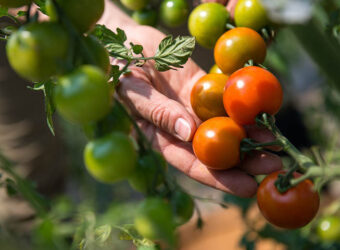Lemon Balm (Melissa officinalis) is an aromatic herb that is used in cooking and in medicine. The lemon scent is very fragrant. There are many plants that are good companions for lemon balm in the garden.
Why Does Lemon Balm Need Companion Plants?
Here are the ways companion plants help lemon balm.
Increase Nutrients
Peas add nitrogen to the soil which lemon balm can take advantage of. Beets have deep roots that bring water and nutrients from deep in the soil. Lemon balm can take advantage of the nutrients and water the beets don’t need.
Benefit from Lemon Balm
Most companion plants for lemon balm benefit from the scent of the lemon balm, which deters pests. Plants also benefit from pollinators that are drawn to lemon balm and will pollinate the plants growing around it. Finally, lemon balm can act as a living mulch. Plants in this category include melons, the Brassica family, tomatoes, squash, berries, radishes, carrots, okra, fruit trees, Allium plants, and lettuce.
Grow Well Together
Some plants just grow well together with lemon balm. Dill, basil, thyme, and mint fall into this category.
You can read more about companion plants in general in my article.
Top 15 Best Companion Plants for Lemon Balm
Here are the top fifteen companion plants for lemon balm and what they do to help grow good crops of lemon balm.
Melons
Watermelons and cantaloupe have sprawling vines with heavy fruit on them. Lemon balm acts as a living mulch if planted between the hills where the vines start. This keeps the melons off the bare ground, reducing pest and rot problems. In addition, lemon balm’s smell deters pests from attacking the melon vines or melons. Lemon balm also feeds and attracts parasitic wasps that will attack caterpillars and other pests.
Beets
Beets are one of the few companion plants that actually benefit from lemon balm. Beetroots can go 36-48 inches down into the soil. They are able to bring up water and nutrients other plants can’t reach. Beets do not use all the water and nutrients, so they excrete the extra into the soil. This makes the water and nutrients available to lemon balm, helping it grow. Plant beets between rows of lemon balm for the best results.
Peas
Like beets, peas add nutrients to the soil. They host beneficial bacteria that take nitrogen from the air and change it into a form plants can use. Peas use the nitrogen to grow, but the bacteria produce more nitrogen than the peas can use. The excess accumulates in the soil around the peas, where it is available to other plants, such as lemon balm. Plant peas in the next row for the best results, or plant lemon balm in the space between rows of peas.
Brassica Family
The Brassica family, which includes plants like cabbage, cauliflower, broccoli, and kale, has a lot of pests after the juicy leaves and buds. Planting lemon balm as a border on the rows of Brassica family members helps repel some of these pests. You can also plant lemon balm between the individual plants in the row.
Tomatoes
Tomatoes have a long list of pests that attack them. Planting lemon balm in a circle around your tomatoes will help repel those pests. That means you get more juicy tomatoes than you would without the lemon balm. You can also plant lemon balm as a border to rows of tomatoes or in the space between rows.
Mint
Lemon balm is in the mint family and grows well with mint. They require similar soil conditions and amounts of water. Mint can be invasive so you may want to put it in a pot rather than in the ground. This keeps it from spreading everywhere.
Squash
Lemon balm provides a living mulch around squash to protect the fruit from resting on the dirt and keep the soil moist. This reduces rot. In addition, lemon balm repels pests looking for a meal of squash. Lemon balm also attracts pollinators, making sure you get as much squash as possible.
Berries
Lemon balm grows well around berry crops like blackberries, blueberries, and raspberries. As a living mulch, lemon balm helps keep the soil moist. Lemon balm attracts pollinators to berries, resulting in a bigger crop. Finally, lemon balm repels harmful insects away from the berries.
Radishes
Lemon balm will help keep maggots, snails, and aphids away from your radishes. The quick-growing radish crop will not interfere with the needs of the lemon balm. Radishes can be grown between rows of lemon balm or in the same row. Or, if radishes are the primary crop, lemon balm can be grown between the rows of radishes.
Carrots
Lemon balm roots spread out rather than down. This makes lemon balm ideal to grow with root crops like carrots because the lemon balm roots do not compete with the carrots for nutrients. In addition, lemon balm repels insects that like to eat carrot plants. You can sow lemon balm in the same row as carrots or in the space between the rows.
Dill
Dill grows well with lemon balm. Plant both in a border around your garden to repel spider mites, a common problem for many plants. You can alternate between lemon balm and dill in the space between the rows to repel pests from high-risk plants such as tomatoes.
Lettuce
Lemon balm will repel spider mites, aphids, caterpillars, maggots, and other pests that like to eat lettuce. Plant the lemon balm in the space between rows of lettuce.
Basil
Basil grows well with lemon balm. Both these aromatic plants will repel insects from nearby plants. Plant these as a garden border or in the row next to the primary crop. Basil can grow quite large, so be sure to plant it far enough from the primary crop so it doesn’t shade the crop too much.
Allium Plants
All of the Allium plants (onions, garlic, leeks, chives) have a strong odor that repels insects. They grow well with lemon balm, which also has a strong odor. Plant lemon balm in the space between the rows so it can keep weeds at bay as a living mulch.
Okra
Plant lemon balm between the rows of okra and around the okra plants so it can act as a living mulch. Lemon balm will keep the soil moist and cooler during the long hot summer while okra produces its fruit.
Fruit Trees
Here, too, lemon balm can act as a living mulch. Not only does it keep the soil moist, but lemon balm will keep weeds from growing and taking nutrients from the fruit trees. If fruit falls, lemon balm will keep it from getting soil on it and slow down rot.
Thyme
Thyme and lemon balm grow well together. They need similar soil and amounts of water. Both can be planted as a border around landscape beds to reduce the number of pests that infest the plants there. Alternate between the lemon balm and the thyme. Both also make good living mulches around plants.
Top 4 Worst Companion Plants for Lemon Balm
These plants should not be planted near lemon balm.
Lavender
Lavender likes it dry. Lemon balm likes the soil moist. If you plant them together, one of them will die, either from drought or from root rot. Group plants according to moisture needs for the best results.
Fennel
Some companion plant guides list fennel as a good plant to grow near lemon balm. Fennel produces a toxin that it excretes into the soil that kills other plants. Lemon balm will not grow well when placed too close to the fennel. Instead, plant lemon balm at a discrete distance of four to six feet from the fennel.
Black Walnut
Black walnuts also produce a toxin that it excretes into the soil. However, the toxin black walnut produces persists in the soil for long periods of time. Do not plant lemon balm within the drip line of a black walnut tree or it will die. Because the toxin black walnuts produce stays in the soil for a long time, do not plant lemon balm where a black walnut tree used to be.
Rosemary
Like lavender, rosemary likes the soil dry and without a lot of organic matter in it. Lemon balm likes rich, moist soil. Planting them together dooms one of the plants to die. Plant rosemary on the dry side of the garden and lemon balm on the moist side of the garden.
In conclusion, lemon balm is planted primarily to repel pests from its companion plants. Some companion plants, such as peas and beets, add nutrients to the soil lemon balm can use. Others just grow well together, such as mint and dill. Good companion plants for lemon balm include lettuce, dill, carrots, radishes, berries, squash, mint, tomatoes, the Brassica family, peas, beets, basil, Allium plants, okra, fruit trees, thyme, and melons. Bad companion plants include lavender, fennel, and black walnut trees.






